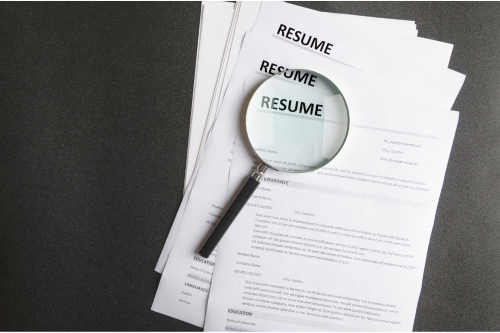Hey, dear job seekers! Are you ready to dive into a topic that could make or break your job-hunting game? We’re talking about the not-so-fantastic world of generic resumes. You know, those one-size-fits-all resumes that might seem like a time-saver, but in reality, are a ticket to the “sea of sameness.” Here’s why:
Years ago while struggling to get called for interviews, I decided to audit my resume. After a deeper dive, I found out what was wrong… the hard way.
Generic resumes are the equivalent of bots – they lack thought and effort and only provide basic information. So, if you’re still getting those robotic rejection emails, you may have an idea of why.
So if you’re in this boat, it’s time to step up your game, put in the effort, and create a resume that truly represents who you are and what you’re capable of.
In this article, we will talk about:
- Why you should ditch generic resumes
- How to write a resume that gets you noticed
- Getting your professional image right
- Identifying the generic mistakes that can hold you back
Why You Should Ditch Generic Resumes
Generic resumes can often get lost in the shuffle, failing to make a lasting impression on potential employers. Here’s a few reasons why ditching generic resumes in favour of customized ones can significantly enhance your job search success.
Failing to Stand Out
Creating a generic resume is tempting for job seekers who want to apply for many positions at once. However, by using a generic resume, you run the risk of not standing out among other applicants.
Recruiters and hiring managers are drowning in resumes, and if yours doesn’t grab their attention in 6 seconds, it won’t get you to the interview.
Customizing your resume to the specific job description and responsibilities you’re applying to makes a HUGE difference in catching their attention.
Missing Important Keywords
Another issue with generic resumes is the lack of industry-specific keywords and buzzwords. You know, the secret language that can open doors to your dream job? A generic resume doesn’t speak that language.
Including these keywords will align your resume better with the job description and will demonstrate you actually read the job description, rather than skimmed over it.
Most importantly, it will help you pay very close attention to something many of us ignore.
Ignoring Applicant Tracking Systems
Nowadays, many companies use these super-smart systems called Applicant Tracking Systems (ATS) to filter through resumes. These systems scan resumes for essential qualifications and relevant keywords. If your generic resume lacks such important details, your application probably won’t reach the hiring manager’s desk.
Including job-specific keywords that appear in the job advertisement significantly increases your chances of passing through the initial screening and landing an interview.
So, while generic resumes are a time-saver, they could cost you some great job opportunities. The better path? Tailor your resume for each job by highlighting specific qualifications and experiences and including important keywords directly from the job ad.
Crafting a Resume That Shouts ‘Pick Me!’
Tailoring to Job Description
You need to personalize that resume like it’s a tailored suit. But how?
It’s actually not that complicated. First up, analyze the job posting thoroughly, like your favourite detective on a crime scene. Ask yourself:
- What are they looking for?
- What skills and qualifications do they fancy?
- What specific responsibilities and tasks are mentioned?
- Which keywords or phrases are repeated or emphasized?
Focus on including the most relevant skills, experience, and qualifications that match the job requirements.
Valuable tip: Use action verbs and clear bullet points to illustrate your work experience effectively. Don’t forget to include relevant job titles and your contact information on your resume.
Highlighting Achievements
The best advice: showcase your most significant achievements. Don’t just list your past jobs and call it a day. Show off those wins!
Start by assessing your past work experience to identify key accomplishments. Did you boost sales by 30%? Manage a team like a pro? Or maybe you’re the Einstein of cost-saving, saving your company a cool $50,000 annually. Use numbers, percentages, or any other metric that demonstrates you can contribute to their company’s success too!
Targeting Relevant Skills
Every resume needs the right mix of skills – hard, soft, technical, and anything else important in your industry.
Focus on the skills the job description is looking for. Listing unrelated skills may dilute your resume’s focus and could reduce your chances of getting an interview. By tailoring your resume to the job, highlighting your achievements, and locking onto the right skills – you’ll be one step closer to landing your dream job.
Nailing That Professional Image On Paper!
Design and Formatting
Ever heard the phrase, “dress for success”? Well, your resume deserves some dressing up too. It is essential to create a professional image. No one likes to read a cluttered, chaotic resume. So pay attention to things like clean fonts and proper spacing.
Use bullet points, bold text, and whatever formatting magic you’ve got to make the essential bits like your skills, achievements, or job responsibilities “pop” for hiring managers.
But be cautious. Especially with the use of colours and graphics. While a dash of creativity is nice, don’t go overboard. You’re not entering a design contest. Also, avoid common mistakes such as spelling errors and grammatical blunders. Always proofread your resume multiple times to eliminate any errors and maintain readability.
Language and Tone
Language and tone matter in the professional world. Ensure that you use concise and direct language. Ditch the jargon and clichés. Instead, let action verbs and industry-specific keywords do the talking. Maintain a professional and friendly tone throughout your resume. This balance can showcase your ability to fit into the company culture and communicate effectively with colleagues and clients. Remember, you’re not just impressing robots (ATS), but also showing you’re a good fit for the team!
Resume Summary
Forget those generic objective statements. Go for a personalized summary that screams, “I’m the one you’re looking for!” Highlight your best stuff, like your top skills and achievements. It serves as an introduction to the rest of your resume and can encourage recruiters to continue reading.
Don’t Let these Resume Mistakes Hold You Back
From typos to irrelevant information, there are basic mistakes that can prevent you from landing an interview. Learn about the common resume mistakes and how to avoid them to ensure your application stands out to potential employers.
Including Irrelevant Information
Only include relevant information showcasing your skills and experience for the job you’re applying for. Your resume is not your life story; it’s your professional highlight reel. So, skip the irrelevant details like hobbies and interests, as it may distract potential employers from focusing on your professional qualifications.
For example, unless you’re applying for a graphic design position, it’s not necessary to highlight your proficiency in Photoshop and Illustrator. Instead, focus on presenting your relevant work history and years of experience in the field.
Using Incorrect Contact Details
This one should NEVER happen, but it does. From an employer’s perspective, it is the height of carelessness. Not to mention the potential for missed opportunities because you didn’t double-check if your phone number or email is correct.
The easiest way to avoid this is to work off of a master copy where your contact information is already there. That being said, always double-check before hitting send. You never know when your finger (or your kid’s) accidentally hit a key, preventing you from ever hearing back from your dream job.
Not Proofreading
Speaking of double-checking things, one of the most common resume mistakes is neglecting to proofread. Typos and grammatical mishaps can also leave a negative impression on employers, suggesting carelessness and a lack of professionalism. Read it over, use spell check, read it over again, and try and get a friend to give it another once-over.
So, there you have it. No more generic resumes – tailor yours to the job, highlight your achievements, and target the right skills and watch those interview offers roll in. It’s time to create a resume that shouts, “Pick me!” 😏




